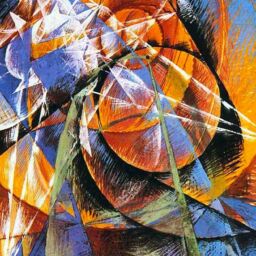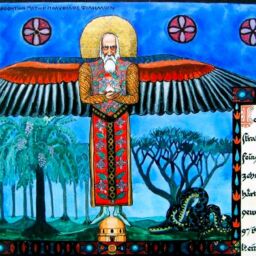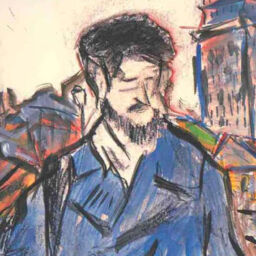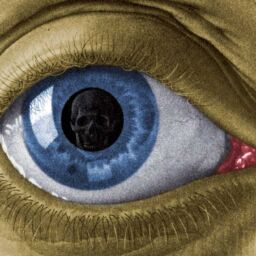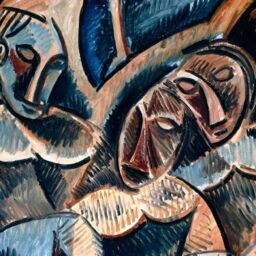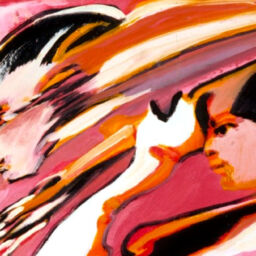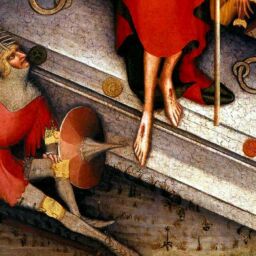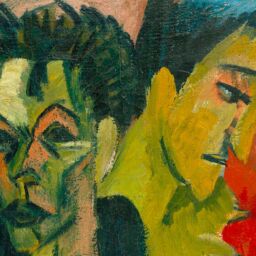
The Inferior Function – A Moral Issue
Angelo Spoto, October 4, 2011
 The inferior function puts Jung’s theory of types in its most dramatic guise. It heats things up and agitates. It evokes from us a shudder, a sigh, and a gasp. The inferior function is our trouble-maker. It confutes, refutes, and complicates. It flips things around and inside-out. It challenges whatever we have accomplished, mocks our savvy, takes our daily bread. It stops us in our tracks.
The inferior function puts Jung’s theory of types in its most dramatic guise. It heats things up and agitates. It evokes from us a shudder, a sigh, and a gasp. The inferior function is our trouble-maker. It confutes, refutes, and complicates. It flips things around and inside-out. It challenges whatever we have accomplished, mocks our savvy, takes our daily bread. It stops us in our tracks.
Perhaps what is most devastating to us, the inferior function acts in all these ways on its own. That is, the inferior, along with its archetypal compatriot the shadow, can take on a kind of active and authoritative presence in our everyday lives. In its most diabolical aspects, it tampers with and sabotages our relationships, turning friend into foe, or intrapsychically speaking, Self into non-self. In the blink of an eye, the inferior function can go from a “what” to a “who,” from you to your neighbor, from your neighbor back to you. Jung explains:
The essence of the inferior function is autonomy. It is independent, it attacks, it fascinates, and so spins us about that we are no longer masters of ourselves and can no longer rightly distinguish between ourselves and others. (CW 7, para. 85)
Yet amidst all our trepidation, we would likewise be reminded by Jung that “it is necessary for the development of character that we should allow the other side, the inferior function, to find expression” (Ibid.). The ego asks why anyone in his or her right mind should actually allow the troublesome aspects of his or her personality to be expressed. Jung’s answer is “for the development of character.” This remark, less a warning than an evocation, is our motive for devoting special attention and a separate section to this strange part of Jung’s typology. For Jung, the inferior function is thus not just a trouble-maker extraordinaire, it is a moral exigency as well.
Character, morality, and personality are all inextricably connected in Jung’s psychology; they are all products of coming to terms with the energy of the psyche and the “fundamental laws of human nature” (CW 6, para. 356). However, unlike many moralists, Jung does not focus his attention on external laws, codes, or decrees as the primary sources of morality. That is, an individual’s morality is not understood from the outside looking in, nor are character and personality ultimately judged or shaped by any outside authority. Rather, the roots of morality are posited inside one’s own deepest nature as an individual; morality itself extends out from the person to the world.
In this way, a person’s unconscious reliance on external laws, rules, and restrictions seems more an indication that one is lacking in true morality, that one needs something from the outside to control the otherwise unknown or unmanageable forces of the personality, that one distrusts nature, or finally that one is out of harmony with oneself and one’s world. Naïve dependency on external laws, rules, and restrictions could be thought of as conditions of the persona, the necessary and convenient mask a person wears to adjust to the demands of the external everyday world.
As such, obeying the law becomes a concession the individual makes to society that in effect cuts off certain aspects of the personality from being experienced and expressed. Favoring the persona over other aspects of the personality thins out a person’s overall psychological presence. Such posturing in effect precludes the possibility of being in harmony (a joining together, agreement, concord) with oneself or the world, as too much of oneself and the world is missing. Jung comments,
Every man is, in a certain sense, unconsciously a worse man when he is in society than when acting alone, for he is carried by society and to that extent is relieved bf his individual responsibility. (CW 7, para. 240).
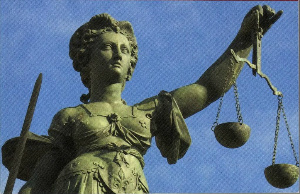 Psychologically speaking, then, such external laws rooted in society can block or inhibit the individual from exploring and relating to parts of the personality that must be taken into consideration if one is to be both authentically moral and psychologically whole. In an important sense, it seems one must know what it is like to break the law in order to be fully human.
Psychologically speaking, then, such external laws rooted in society can block or inhibit the individual from exploring and relating to parts of the personality that must be taken into consideration if one is to be both authentically moral and psychologically whole. In an important sense, it seems one must know what it is like to break the law in order to be fully human.
Yet neither image strikes us as plausible: a world or culture in which there are no external laws or restrictions, or one where everyone goes about breaking the laws that do exist. Nor is Jung suggesting that we live our lives naively through either of those options. How then does the individual find that middle ground where he or she is both free and moral, both an individual and a part of society? One way of answering this question comes from an individual’s confrontation with the inferior function and the shadow.
We have seen that confronting and acknowledging the inferior function and shadow is never as simple a matter as it sounds. The confrontation with the inferior function is not something a person generally seeks out. In fact, more often than not, it is the inferior function that comes after you. You bat it away; it comes back again . . . and again.
The parts of the personality associated with the inferior function and the shadow represent, to varying degrees, just those aspects of our individual and collective lives that the ego as well as all external laws and society seek to cage and tame. For reasons of stability and continuity, society does not want us playing around with our dark side; but, should these darker aspects of our personality continue to press upon consciousness, we too are most eager and willing to push them aside or away.
When given the opportunity to look at or claim our own dark side, we most commonly and conveniently project it onto something or someone else and then go on about our business as if nothing happened; persona strained, ego intact. Projection, then, is a pivotal psychological concept in any discussion of the inferior function as a moral problem, both on the individual and collective levels. The concept of projection brings us closer to the raw effects of an individual’s psyche operating in the everyday world. Through the mechanism of projection, Jung explains, “everything that is unconscious in ourselves, we discover in our neighbor and we treat him accordingly” (CW 10, para. 131).
The term itself, which Jung adapted from Freud, means an unconscious, unperceived, and unintentional transfer of energy of the subjective psychic elements onto an outer object. Jung also speaks of a “hook” that in everyday life serves as the object upon which the subjective psychic contents are projected (CW 8, para. 99).1 What is important to realize here is that any psychic content can be projected onto any “fitting” object (person or thing). Therefore, in a vast variety of our projections, we have represented a vivid and panoramic display of psychic energy moving from the subjective unconscious to the objective world. Projections thus are the most immediate testimony of the unconscious operating in the world, as well as potentially one of the most damaging and dangerous characteristics of the human personality.
Let us first look at some “domestic” versions of projection that highlight the moral dimension involved in dealing with the inferior function. When a person projects aspects of his or her personality onto an object with which the ego is in accord (usually thought of as the “good” aspects of the personality), one may assume that the projection serves to bring the object closer to the person. This “intimacy” may eventually make for an increase in mutual understanding between the subject and object. Perhaps if the object were another person, projection in this sense may initiate what would become a friendship. Unconsciously, we often first see the virtue we believe to be in ourselves in just such a friend. Consciousness too is liable to rally to establish supportive “facts” and then go on to “test” the information gathered over time. With some work on both sides, perhaps the friendship will prove true and lasting.2
On the other hand, when a person projects aspects of his or her personality with which the ego is at odds (usually thought of as “bad” aspects of personality, or the inferior function), then projection may in fact serve to distance the object from the subject. The relationship between subject and object now becomes disdainful, repulsive, and even hateful. The object is so tinged with the negative aspects of the subject’s unconscious that we may truly speak of it as the “enemy.”
Unfortunately, the inferior function is often expressed through just such a projection. Jung comments, “. . . what we combat in the other person is usually our own inferior side” (CW 10, para. 131). The ego and consciousness, once infected with the inferior function in this sense, can bring ruin to the enemy, or (as easily) to oneself.
Even under the best of conditions, when consciousness is functioning normally for us, we are mutually vulnerable to the degree that we simply do not know the other person well enough. When we are not conscious of what is going on in regard to the other person, the unconscious is often around to fill the vacuum. Unfortunately, having to face the unfamiliar or the unknown often makes us mutually suspicious and fearful. The poet James Agee expresses this everyday sentiment in poignant terms:
Almost any person, no matter how damaged and blinded, is infinitely more capable of intelligence and joy than he usually knows, and even if he had no reason to fear his own poisons, he has those in others to fear, to assume and take care for if he would not hurt both himself and that other person and the pure act itself beyond cure. (Agee, 1960, p. 590)
The various complications and ramifications of projection on the personal and interpersonal level, not to mention how such energy can become politicized, are truly inexhaustible.
Because the inferior function is so tied to the archaic and barbaric side of an individual’s personality, we must realize that the inferior function, when it is at the heart of such projections, can actually be dangerous. Relating to the inferior function then becomes a problem of the first order because, as Jung comments, “barbarism must first be vanquished before freedom can be won,” and freedom is won, as he states in Psychological Types, when “the basic root and driving forces of morality are felt by the individual as constituents of his own nature” (CW 6, para. 35).
To give us a better idea of how projection works, Jung draws our attention to what he calls “the archaic mind” (CW 10, paras. 127-47). He does not mean here to point disparagingly to the “barbarism” of primitive culture; “barbarism” as such would only be a criticism a modern culture could make upon itself. Instead, by studying primitive cultures and religion, Jung creates a fertile point of contact between modern civilization and our own inherited ancestral psychology, a connection Jung fully explores in dealing with the archetypes of the collective unconscious (CWs 5, 8, 9i, 9ii, 12-14). As the inferior function is the doorway to the unconscious, special attention is warranted to appreciate how this dimension in one’s life can play itself out.
 Drawing chiefly upon the work of the anthropologist Levy-Bruhl, Jung posits that “projection results from the archaic identity of subject and object, but is properly so called only when the need to dissolve the identity with the subject has already arisen” (CW 6, para. 783). The last point in this quote is especially significant. Unless or until it becomes necessary for a person to differentiate between the subject and object, projection will take place at a level which is often naively assumed to be the actual state of affairs; i.e., our projections are taken for reality as it must be. For the most part, projection in this sense gives us the illusion necessary to maintain our unconscious lives in the external world (participation mystique). The individual is accordingly eclipsed by the object which carries his or her (unconscious) projection.
Drawing chiefly upon the work of the anthropologist Levy-Bruhl, Jung posits that “projection results from the archaic identity of subject and object, but is properly so called only when the need to dissolve the identity with the subject has already arisen” (CW 6, para. 783). The last point in this quote is especially significant. Unless or until it becomes necessary for a person to differentiate between the subject and object, projection will take place at a level which is often naively assumed to be the actual state of affairs; i.e., our projections are taken for reality as it must be. For the most part, projection in this sense gives us the illusion necessary to maintain our unconscious lives in the external world (participation mystique). The individual is accordingly eclipsed by the object which carries his or her (unconscious) projection.
This is what happens on a regular basis in primitive culture, though less so in modern culture, given the primacy of the individual and the evolution of modern ego-consciousness. In primitive culture, the individual is subordinate to the collective, whose myths and rituals represent how things must be. The myths carry the projections for the group; the rituals carry the power to mediate the projections. Everyone knows how and why they are what they are simply by being a part of the group.
Because primitive cultures project so much of the unconscious, one should not think that a certain amount of differentiation is not taking place; it is simply of another kind—a second-order differentiation in comparison to modern ego-consciousness. Primitive consciousness is based on the collective unconsciousness; modern consciousness, on the other hand, must work through the personal unconsciousness, the hidden life of the individual, to a deliberate awareness of the collective unconsciousness. In other words, modern consciousness is based on the individual and so must return there first when problems arise. Primitive man, unlike modern man, has no need of anything as personally indicting as an “inferior function” to draw his attention back to his collective psychology.
In other regards, the differentiation that takes place in external reality for primitive consciousness can be compared with the differentiation that takes place at the subjective level for modern consciousness. Both forms of consciousness are capable of great complexity, as modern psychology and primitive ritual amply demonstrate, but both cultures remain alien or strange to each other.
When projection does take place in modern culture, matters are actually more difficult to manage, due to the personal investment of energy which is absent in primitive cultures. In order to preserve our relationships with the objects of our projections and to maintain our personal continuity with the world as we have come to know it through our projections, we moderns often go to bizarre extremes to validate and stabilize our projections. This usually involves a special act of ego-consciousness itself (e.g., will to power), or at least the pretense of such. When consciousness becomes so entangled with projections, it becomes itself distorted or “false.” In our modern culture this means we often act to justify our projections as being “logical,” “normal,” “right,” “rational,” etc., all the while refusing to recognize such attributes for what they are: the biases, defenses, and rationalizations of an often unsure and embattled ego. Projection of this kind amounts to a sophisticated form of narcissistic entitlement.
In more ancient times, projections were part of elaborate religious systems and mythologies that in turn would help the archaic mind mediate the forces of the unconscious at a level closer to the source of the projections themselves (namely, the archetypes). Strictly speaking, without individual consciousness to intervene and complicate matters at the subjective level, projections of the archaic mind could never be thought of as “false,” or even pretentious. Because primitive man did not have the problem of consciousness to contend with as we moderns do—i.e., because he lived in a world where the individual was not an important issue—projections were for him simply and surely the truth. In Jung’s formulation, “Primitive man is unpsychological. Psychic happenings take place outside him in an objective way. Even the things he dreams about are real to him; that is the only reason for paying attention to dreams” (CW 10 para. 128).
At least in ancient times (and now, wherever religion is still a factor in a person’s life), religious systems and mythologies had the advantage of forcing people to take their projections seriously, as objective facts that must be attended to with care and deliberation. In return for this seriousness, a person was assured a rightful place in the cosmos and a meaningful existence. This is no mean achievement, as an age that is described by many as meaningless, boring, and alienating should readily realize. However, instead it takes something like our own sophisticated and biased culture to “see through” the cultures and mythologies of times past as nothing but a collection of naïve superstitions or lies. We moderns of course do not consider ourselves so fortunately “deceived” as our ancient counterparts.
 Unfortunately too, we have not yet been able to come up with much that can handle the forces of the unconscious as effectively as did the older religions and mythological systems of other times and places. The best many moderns can do is to claim technology for their religious system and mythology.3
Unfortunately too, we have not yet been able to come up with much that can handle the forces of the unconscious as effectively as did the older religions and mythological systems of other times and places. The best many moderns can do is to claim technology for their religious system and mythology.3
In any case, the nature of projection now and then is the same: in projection, we are cleverly disguised to ourselves in the object of our attention. Historically speaking, the modern ego and consciousness are relatively late developments that ideally will mature to help the individual sort through the participation mystique that is the common characteristic of all projections. Jungian psychology may in fact be thought of as especially modern in this sense, as it is specifically meant to help us finish this task of consciousness (Edinger, 1984). Jung himself, speaking as a modern in the best sense of that term, comments:
Our age wants to experience the psyche for itself. It wants original experience and not assumptions, though it is willing to make use of all existing assumptions as a means to this end, including those of recognized religions and the authentic sciences. (CW 10, para. 173)
Such is, in fact, the experiment of modern consciousness. However, as good as it sounds here, one must truly be concerned over the eventual price humankind will have to pay for its experiment. If one observes how easily and how often we moderns continue to project the negative aspects of our unconscious onto our neighbor, one is convinced neither of our general psychological understanding nor of our humanity. Indeed, there seems to be something especially hypocritical about a culture and society that so prides itself on its knowledge and accomplishments, and yet whose members still project so much of their dark side onto one another. Jung warns,
The unconscious has an inimical or ruthless bearing towards consciousness only when the latter adopts a false or pretentious attitude. (CW 7, para. 346)
There are other considerations to take into account about our modern lives and the rise of modern consciousness. Because civilization and technology put so much destructive power at our disposal, and because as a rule we are so reluctant to own up to our negative projections, we are individually and collectively more at risk to ourselves and others than ever before in human history. To some this apprehension may seem unnecessarily apocalyptic. Since progress and technology are often believed to be the hallmarks of modern culture and capable of solving any problem, it is tantamount to heresy to question their authority and saving presence in our world.
But an eruption from the unconscious would testify to an inscrutable power that could easily dwarf any recent technological achievements. Again, Jung warns:
Let man but accumulate sufficient energies of destruction and the devil within him will soon be unable to resist putting them to their fated use. (CW 10, para. 163)
Unfortunately, it is probably reasonable to say that those who identify too easily or glibly with our technologically sophisticated culture and who view projection as something only “the other guy does” are also those individuals whose devils grow most restless. Those too who look condescendingly at primitive cultures as nothing but a concatenation of mistakes, lies, and phantoms of the imagination, probably themselves deny having anything remotely resembling an “inferior function” or shadow. Just so, these individuals put themselves (and everyone around them) at greater risk.
The volatile situation in the modern world should put us all on guard about how we deal with our respective inferior functions, especially those who are capable of abusing the power of technology as a destructive vehicle of inferior expression: I mean here the scientists and the politicians who are in leadership roles in their respective professions. The mythology that modernity presents to us, a mythology that says among other things that we do not need mythology, is infinitely more destructive than what any ancient or primitive culture would have been capable of enacting. We all in this sense need to be psychologists or students of the psyche.
 It is becoming increasingly obvious that our moral education and sense of individual responsibility have not kept up with our technological progress as a culture; and increasingly fewer of us have the mediating influences of organized religion to help us sort through our projections in any meaningful way. This makes us all especially vulnerable should the unconscious erupt in a negative form. Combine this situation with the amount of technological power at our disposal and one can understand the anxiety that seems to be so much a part of modern life. In the depths of the modern psyche is the abject fear that what we have created in our own image has turned against us, has gone out of control, has become destructively “other.”
It is becoming increasingly obvious that our moral education and sense of individual responsibility have not kept up with our technological progress as a culture; and increasingly fewer of us have the mediating influences of organized religion to help us sort through our projections in any meaningful way. This makes us all especially vulnerable should the unconscious erupt in a negative form. Combine this situation with the amount of technological power at our disposal and one can understand the anxiety that seems to be so much a part of modern life. In the depths of the modern psyche is the abject fear that what we have created in our own image has turned against us, has gone out of control, has become destructively “other.”
We now have no alternative but to take the battle literally to heart, or risk acting out the battle in a world we profess to know so well. This is precisely what Jung is calling our attention to in his evocations of the inferior junction as a moral issue. “The upheaval of the world and the upheaval of our consciousness are one and the same” (CW 10, para. 177), he tells us soberly. If we persist in being blind to the forces of the unconscious in our individual and collective lives and remain sadly naïve about the uses and abuses of our science and technology, catastrophe certainly awaits us. It would be tragic indeed if we had to learn this lesson at the expense of the very culture we so extol.
Notes
1Marie-Louise von Franz (1985) has provided an exhaustive and insightful treatment of this topic in her book Projection and Recollection in Jungian Psychology. In the foreword she comments, “If nothing but epistemological considerations were involved [in looking at problems associated with projection], perhaps we could let the matter drop; but the phenomenon of projection is also an eminently moral and practical problem . . . “
2Of that special friendship we call marriage, I am unable to confirm Jung and von Franz’s conclusion that people tend to marry their typological opposites in order to complement their own types (see CW 17, paras. 324-345, and von Franz, 1984, p. 4). Their rationale is that individuals marry through an unconscious motivation, to insure that their respective inferior parts would be taken care of by the partner. In this sense, a strongly introverted thinking type would seek out an extraverted feeling type to become “whole,” each using the marriage relationship to avoid owning up to and integrating the inferior part of his or her personality. The fact that such did not go smoothly is what interested Jung.
Marriage today is a different kind of refuge. I would advance the hypothesis that opposite types are indeed still unconsciously attracted to one another, but usually in the context of short-term extramarital relationships. As a consequence, for many couples marriage is not the hotbed of individuation it may once have been. For various reasons, individuals are consciously looking for something psychologically safe in a marriage partner, which is later compensated for, at the unconscious level, through a “dangerous (exciting, romantic) affair.” With respect to marriage, desire has given way to the “sharing” of a life together; the security of mutual similarity is winning out over exasperation at the prospect of having to work out “irreconcilable differences.”
3It is no longer unusual to see back-page articles in the newspaper such as the one by Lee Siegel (Associated Press, August 28, 1988), entitled “Atom Smasher’s Glitches Block View of God’s Mind”:
LOS ANGELES—Physicists wanting to “understand what’s in the mind of God” are frustrated by glitches in a new $115 million atom smasher that someday may yield secrets about the makeup of matter and the birth of the universe.
May we presume that the physicists who find this information know how to handle their newly acquired knowledge?
* Editors’ Note: This article was reprinted, with the author’s permission, from Jung’s Typology in Perspective, by Angelo Spoto, Revised Edition, (1995), Wilmette, IL: Chiron Publications. We learned on October 1st that this reprint is being simultaneously published by The Jung Center of Houston.
References
Agee, J. (1960). Let us now praise famous men. Cambridge, Mass.: Riverside Press
Edinger, E. F. (1984). The creation of consciousness: Jung’s myth for modern man. Toronto: Inner City Books.
Jung, C. G. The collected works of C. G. Jung, trans. R. F. C. Hull. Bollingen Series XX, vols. 1-20. Princeton, NJ: Princeton University Press.
(1953, 1966). Two essays on analytical psychology. CW 7.
(1923, 1977). Psychological types. CW 6.
(1970). Civilization in transition. CW 10.
(1960, 1969). The structure and dynamics of the psyche. CW 8.
(1954). The development of personality. In CW 17.
von Franz, M.-L. and Hillman, J. (1984). Lectures on Jung’s typology. Dallas: Spring Publications.



